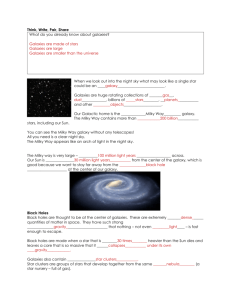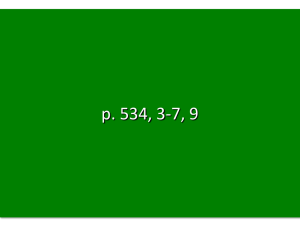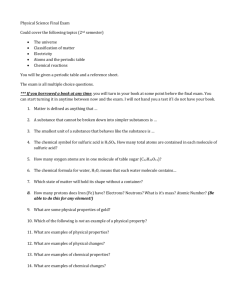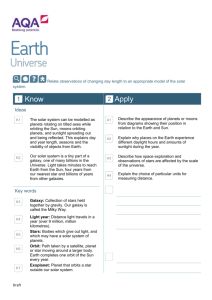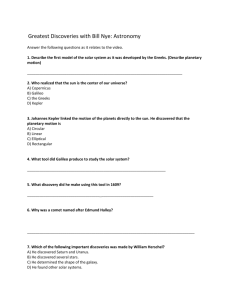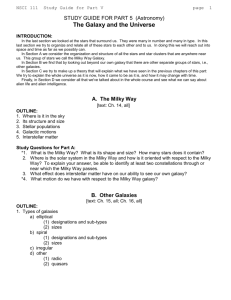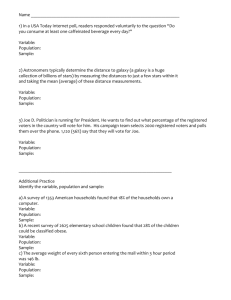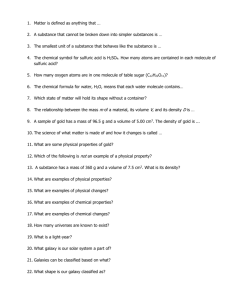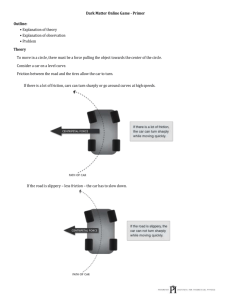AST 101 INTRODUCTION TO ASTRONOMY SPRING 2008
advertisement
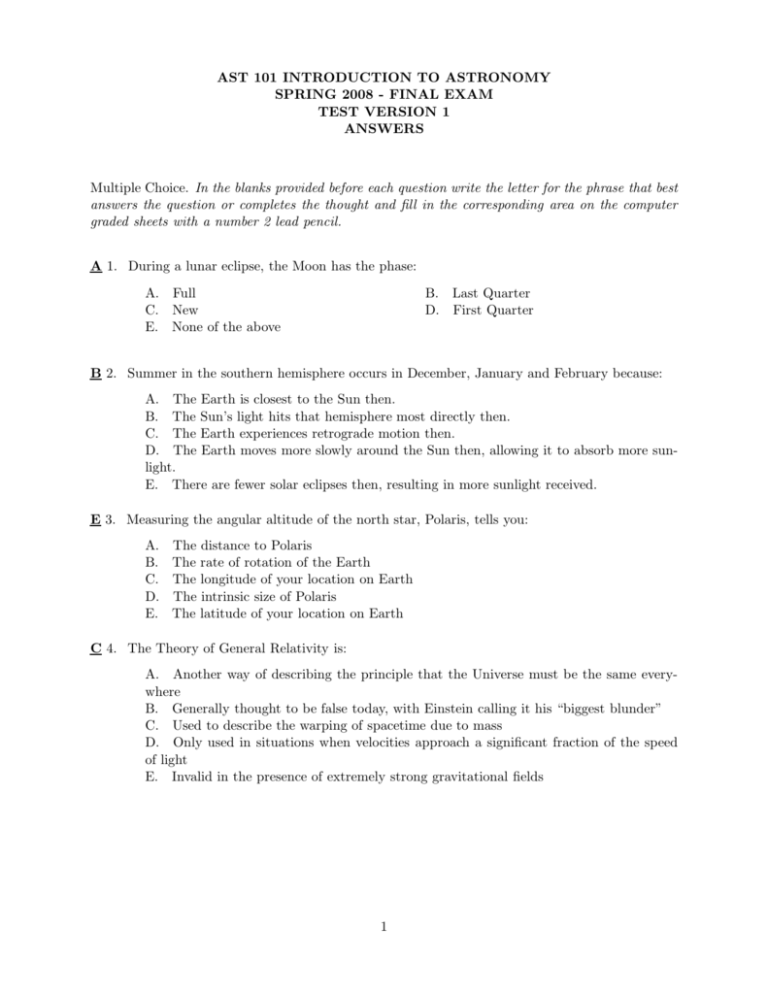
AST 101 INTRODUCTION TO ASTRONOMY SPRING 2008 - FINAL EXAM TEST VERSION 1 ANSWERS Multiple Choice. In the blanks provided before each question write the letter for the phrase that best answers the question or completes the thought and fill in the corresponding area on the computer graded sheets with a number 2 lead pencil. A 1. During a lunar eclipse, the Moon has the phase: A. Full C. New E. None of the above B. Last Quarter D. First Quarter B 2. Summer in the southern hemisphere occurs in December, January and February because: A. The Earth is closest to the Sun then. B. The Sun’s light hits that hemisphere most directly then. C. The Earth experiences retrograde motion then. D. The Earth moves more slowly around the Sun then, allowing it to absorb more sunlight. E. There are fewer solar eclipses then, resulting in more sunlight received. E 3. Measuring the angular altitude of the north star, Polaris, tells you: A. B. C. D. E. The distance to Polaris The rate of rotation of the Earth The longitude of your location on Earth The intrinsic size of Polaris The latitude of your location on Earth C 4. The Theory of General Relativity is: A. Another way of describing the principle that the Universe must be the same everywhere B. Generally thought to be false today, with Einstein calling it his “biggest blunder” C. Used to describe the warping of spacetime due to mass D. Only used in situations when velocities approach a significant fraction of the speed of light E. Invalid in the presence of extremely strong gravitational fields 1 E 5. Which of the following statements about Population II stars in the Milky Way is FALSE? A. B. C. D. E. Population II stars are the oldest stars in the Milky Way Population II stars have eccentric, looping orbits Population II stars are found in the Milky Way’s bulge Population II stars are found in the Milky Way’s halo Population II stars are formed in the disk of the Milky Way C 6. A solar eclipse can only happen during a: A. B. C. D. E. First quarter moon. Perihelion passage of the Sun. New moon. Full moon. Solstice. E 7. Which of the following statements about the future fate of our Sun is FALSE? A. The Sun will burn helium into carbon, but never get hot enough its core to burn carbon into oxygen B. When the Sun exhausts all hydrogen in its core it will leave the main sequence C. At the end of its life, all that will remain of the Sun will be a white dwarf D. The Sun will turn into a red giant, expanding roughly to the size of Mars’s orbit and engulfing the Earth E. When the Sun can no longer burn the elements in its core to create energy, it will explode as a supernova C 8. Homogeneity and isotropy, taken as assumptions regarding the structure and evolution of the universe, are known as: A. B. C. D. E. the Grand Unified Theory Wien’s Law The Cosmological Principle Hubble’s Law Olber’s Paradox B 9. Which of the following apparent magnitudes is the faintest? A. −0.2 C. −18 E. +6.4 B. +31.2 D. −3.9 A 10. “Dark Matter” was first discovered through measurement of which of the following? A. B. C. D. E. Galaxy rotation curves Gravitational microlensing of compact objects in the Milky Way halo The velocity of the Milky Way toward the Virgo cluster The velocity of stars deep within the Galactic center The velocity of Andromeda toward the Milky Way 2 B 11. Recent observations of the very high-redshift Universe, using Supernovae Type Ia as standard candles, have revealed what ground-breaking discovery? A. B. C. D. E. Dark matter is actually completely made up of brown dwarfs and black holes The Universe is not only expanding, but it is also accelerating A planet just like Earth, orbiting a star just like the Sun The Milky Way is actually at the center of the Universe The first wormhole which might allow human travel over vast distances D 12. A photon with energy 3eV is absorbed by the hypothetical atom in Figure 1. It is capable of exciting an electron between: A. n=1 and n=2 states C. n=2 and n=3 states E. n=2 and n=4 states B. n=1 and n=3 states D. n=3 and n=4 states D 13. The number of wave crests passing any given point per unit time is called: A. The period of the wave C. The wave speed E. The amplitude of the wave B. The wavelength D. The frequency C 14. Which of the following is not a form of electromagnetic radiation? A. infrared C. neutrinos E. moonlight B. microwaves D. radio waves 3 B 15. The extremely high velocity orbits of stars at the center of our Galaxy are thought to be caused by what? A. B. C. D. E. A mini gamma-ray burster A supermassive black hole An invisible mass made up only of dark matter A Cepheid variable An x-ray binary system C 16. What is thought to be the source of energy in the nuclei of active galaxies? A. B. C. D. E. large clusters of stars binary star evolution massive black holes supermassive supernovae collisions of molecular clouds E (or B) 17. The redshift of a galaxy is: A. B. C. D. E. The rate at which a galaxy is expanding in size How much redder the galaxy appears when observed at large distances The speed at which a galaxy is orbiting around the Milky Way The relative speed of the redder stars in the galaxy with respect to the bluer stars The recessional velocity of a galaxy, expressed as a fraction of the speed of light C 18. A solar eclipse always occurs: A. At sunrise C. At midday E. None of the above B. At sunset D. In the middle of the night B 19. Which of the following statements about the Milky Way’s globular clusters is FALSE? A. Globular clusters were once thought to be older than the age of the Universe B. Like open clusters, Globular Clusters are found only in the Galaxy’s disk C. The color magnitude diagram of a Globular Cluster will show it has lost a large fraction of its main sequence stars D. Globular clusters can contain millions of stars, but usually no gas or dust E. The distribution of globular clusters in the Milky Way is centered on the Galaxy’s core B 20. The fireball from the Big Bang explosion is seen today as what? A. B. C. D. E. nuclear ash, mostly iron and silicon the cosmic microwave background occasional outbreaks of supernovae a large number of old stars northern lights 4 B 21. The Hertzprung-Russell Diagram for stars is a relation between: A. B. C. D. E. B 22. Distance vs. spectral type or temperature Luminosity vs. spectral type or temperature Apparent brightness vs. distance Radial velocity vs. distance Luminosity vs. radius The cosmic microwave background is observed to be a 3K blackbody today, although in the past it must have been much hotter. We detect the peak of its emission today as microwaves. In the past, we would measure: A. B. C. D. E. Nothing, because the photons would not have reached us yet A much more energetic blackbody, peaking at shorter wavelengths A much more energetic blackbody, peaking at longer wavelengths A spectrum also in the microwave region, although it would not look like a blackbody A much fainter blackbody, peaking at longer wavelengths E 23. Collisions between galaxies can: A. B. C. D. E. Hardly ever occur; like stars, galaxies are too far apart, compared to their sizes. Cause large numbers of stars to collide and explode. Cause both galaxies to collapse into a supermassive black hole. Turn ellipticals into spirals. Cause bursts of star formation. From the list below of distance estimators, find the best matches for the phrases that follow, using each only once. A. Tully-Fisher relation B. Type Ia supernova E. period-luminosity relation C. Hubble relation D. parallaxes E 24. Used to estimate distances to Cepheid variable stars B 25. The best technique for directly measuring distances to the most distant galaxies A 26. Uses the rotational velocity of galaxies to estimate luminosity D 27. Useful only for the nearest stars C 28. Use the measured radial velocity to estimate the distance D 29. The small cluster of galaxies to which the Andromeda galaxy belongs is: A. The Fishing Hole C. The Milky Way Neighborhood E. The Solar Neighborhood B. The Small Group D. The Local Group 5 C 30. Early in the Big Bang when temperatures are extremely high, particles can be created out of the radiation field. Which of the following statements about the creation of matter is FALSE? A. Matter and energy are related, according to Einstein’s E = mc2 . B. For unknown reasons, there happened to be slightly more matter than antimatter at the moment all the newly formed particles “froze out”. C. For every negatively charged electron formed, a positively charged neutrino was formed at the same time; the particle pair would then annihilate each other. D. For every particle created there was also an antiparticle created of the same mass. E. As the temperature of the Universe dropped, the particle creation rate slowed. D 31. Two philosophical problems with the current Big Bang cosmology are that the Universe seems to be almost perfectly “flat” and that two parts of the Universe, separated by more than the light travel time between them, seem to have identical properties (the “horizon” problem). What suggested theory seems to naturally explain these problems? A. B. C. D. E. A 32. Nothing so far Expansion Acceleration due to dark energy Inflation Grand Unified Theory What is the single most important characteristic in determining the course of a star’s evolution? A. mass C. density E. distance B. absolute brightness D. surface temperature D 33. A detailed analysis of the fluctuations of the cosmic microwave background indicates that the Universe is flat (ie, at “critical density”), with most of its density in the form of what? A. dark matter C. luminous matter E. water B. black holes D. dark energy A 34. Using a spectrograph, you observe a lightbulb as it shines through a cool intervening gas. What do you observe? A. B. C. D. E. An absorption line spectrum A continuous spectrum with both dark absorption lines and bright emission lines An emission line spectrum A continuous spectrum with bright emission on top A continuous spectrum 6 B 35. To a first approximation, a rough maximum age of the Universe can be estimated using which of the following? A. B. C. D. E. The age of the oldest open clusters 1/H0 , the Hubble time The age of the Sun The age of the Galaxy There is no simple estimate A 36. The best way to write 567903 in scientific notation is: A. 5.67 x 105 C. 6 x 104 E. 5.67 x 106 B. 6 x 103 D. 5.67903 x 105 D 37. Which of the following statements about neutron stars is FALSE? A. Neutron stars are as massive as the Sun, but only about 10 km across B. Neutron stars spin very fast C. Neutron stars are supported by neutron degeneracy pressure D. If a person could survive this experiment, a scientist would weigh more standing on a white dwarf than standing on a neutron star E. Newly formed neutron stars are thought to have an active phase making them “blink” as pulsars C 38. Nearly all the elements in the Universe are formed in the cores of massive stars, except: A. iron and nickel C. hydrogen and helium E. helium and nitrogen D 39. B. carbon and oxygen D. silicon and sulfur Which of the following reasons for taking repeated individual measurements during a scientific experiment is FALSE? A. Increasing the number of repeated measurements reduces the overall error in your measurement B. Multiple measurements reduce the impact of a single bad measurement on your final answer C. Taking the average of repeated measurements increases the accuracy of your final result D. Taking multiple measurements allows you to choose the ones that seem to be most correct and throw out the incorrect ones E. Repeating the measurements gives a sense of how reproducible your experiment is for other scientists 7 B 40. If the density of the Universe is less than critical, then the Universe: A. B. C. D. E. Will ultimately collapse back in on itself Will expand forever Must be spherical Will have a temperature of 2.73K forever Must be static, with an unknown cause for the redshifts E 41. The predominant model of galaxy formation is: A. Like star formation, large galaxy clusters formed first and then the clusters fragmented, forming galaxies last. B. About a minute after the Big Bang, galaxies began to form in galaxy, anti-galaxy pairs just like particles C. Elliptical galaxies form first and then each turns in to a spiral galaxy D. Gamma-ray bursters triggered the first generation of galaxies to form E. The hierarchical model, where small galaxies formed first and then merged into larger and larger galaxies Match the list of objects below with the phrases that best matches it, using each only once. A. White Dwarf B. Event Horizon C. Pulsar D. Neutron star E. Black Hole C 42. Spinning compact objects that seem to blink like lighthouses D 43. The degenerate remnant from the supernova explosion of a star with less than 20 solar masses B 44. The effective “surface” of a black hole whose size is characterized by the Schwartzschild radius E 45. The most massive stars in the Universe leave this behind after they go supernova A 46. What is left over after a planetary nebula’s outer gas shells have drifted away A 47. Galaxy A has a radial velocity of 1000 km/s while Galaxy B has a velocity of 4000 km/s. According to Hubble’s law, which of the following statements are TRUE? A. B. C. D. E. Galaxy B is farther away than Galaxy A Galaxy B is rotating faster than Galaxy A Galaxy B appears redder than Galaxy A Galaxy A will collide with Galaxy B Galaxy A is farther away than Galaxy B 8 E 48. Using Newton’s version of Kepler’s 3rd law, what do we need to know to determine the mass of the Sun? A. Its temperature as found by Wien’s Law. B. The exact timings of the transits of Venus and its diameter. C. Its density as found by spectroscopy. D. The Earth’s diameter and the eccentricity of its orbit. E. The size of the A.U. and exact length of the year (we may neglect the mass of the Earth). From the list below of galaxy types, find the best matches for the phrases that follow, using each only once. A. ellipticals B. irregulars C. dwarf ellipticals D. active galaxies E. spirals E 49. Disks with central bulges surrounded by spherical halos of old stars B 50. Have very chaotic structure with no apparent symmetry D 51. Often have radio jets extending from their cores, aligned with their minor axes C 52. Thought to be remnants of the original building blocks of all galaxies A 53. Giant spheroidal galaxies typically having no apparent structure C 54. The large scale structure of the Universe has a shape reminiscent of: A. Waves in the ocean, where the galaxies all lie upon regularly spaced lines like the ridgelines of incoming waves B. Checkers on a checkerboard, with galaxies spaced smoothly at the same, regular distance from each other C. Soap bubbles, where the galaxies sit along the surfaces of bubbles which are strung along long soapy filaments D. A large, 3-D sphere, with all the galaxies sitting on the surface of a sphere surrounding the location of the Big Bang E. A giant turtle, and the Earth rides on its back A 55. When you hear the pitch (frequency) of a train’s whistle change as it moves away from you, this is an example of which of the following: A. B. C. D. E. The Doppler effect Parallax Time dilation, following the rules of special relativity Wien’s law The Hubble expansion 9 D 56. Spiral galaxies are subdivided into types Sa, Sb, and Sc based on: A. B. C. D. E. Overall size of their disk The relative speed of their rotation curve The relative ellipticity of their disk The relative size of their bulge and how tightly wound their spiral arms are The age of their stars C 57. Why is a black hole called “black”? A. B. C. D. E. light coming from behind shines right through it it is so small you can’t see it light can’t escape from it matter becomes highly absorbing when strongly compressed it’s so deep that only light shining from directly overhead will illuminate the center A 58. At visible wavelengths, some regions of the Milky Way’s disk appear dark because: A. B. C. D. E. Stars in that direction are obscured by interstellar dust. Stars in that direction only give out light at non-visible wavelengths. There are no stars there. There are numerous black holes there that capture all the star light behind them. The magnetic field has directed the polarized light away from these regions. E 59. You accidentally drop an indestructible probe (complete with running lights and a visible clock) near a black hole, and watch it fall in. Which of the following statements is NOT TRUE about what you would see? A. The probe’s clock would appear to stop when it reaches the event horizon B. After the probe passes through the event horizon you would see its image frozen, stuck at the place and time it crossed over C. The lights on the probe would appear to change color, becoming redder D. The probe’s clock would appear to slow down E. Once inside the event horizon, you would see the probe compress in size, becoming infinitely small and infinitely dense B 60. Spiral galaxies have spiral arms with a distinct bluish color, caused by what? A. B. C. D. E. A very hot interstellar medium Recent and ongoing star formation Solar type stars Blueshifted supergiant stars Dust and giant molecular clouds 10 The ultimate fate of the Universe depends upon the overall geometry of spacetime. Each of these geometries has implications for the relative size of the Universe as time progresses. In Figure 2, the relative size of the Universe is graphed as Distance vs. Time for the three primary geometries, labeled A, B, and C. Answer the following three questions about this Figure. A 61. Curve A describes which type of Universe: A. B. C. D. E. Open, where the Universe will continue to expand forever Hyperbolic, where the expansion of the Universe becomes exaggerated Flat, where parallel lines never meet Closed, where the Universe will ultimately re-collapse Parallel, where multiple Universes parallel our own evolution B 62. Curve B describes which type of Universe: A. B. C. D. E. Open, where the Universe will continue to expand forever Flat, where parallel lines never meet Parallel, where multiple Universes parallel our own evolution Hyperbolic, where the expansion of the Universe becomes exaggerated Closed, where the Universe will ultimately re-collapse C 63. Curve C describes which type of Universe: A. B. C. D. E. Flat, where parallel lines never meet Parallel, where multiple Universes parallel our own evolution Closed, where the Universe will ultimately re-collapse Hyperbolic, where the expansion of the Universe becomes exaggerated Open, where the Universe will continue to expand forever 11 True/False: In the blanks provided before each question write whether the following statements are True (T) or False (F). On your answer sheet, use A for True and B for False. T 64. When two galaxies merge, new stars are often formed in the process T 65. A spiral galaxy has both old and young stars F 66. Seyfert and radio galaxies have very different mechanisms that cause them to be “active” galaxies F 67. Elliptical galaxies often have significant amounts of gas and dust Photon A has a wavelength of 1000nm and Photon B has a wavelength of 400nm. Indicate whether the following statements about these photons are True (T) or False (F). F 68. T 69. F 70. F 71. Photon A is more energetic than Photon B. Photon A is redder than Photon B. Photon A has a greater frequency than Photon B. Photon B is moving faster than Photon A. Star A is an M-type main sequence star and Star B is a B-type main sequence star. Indicate whether the following statements about these stars are True (T) or False (F). F 72. F 73. T 74. T 75. Star A is more luminous than Star B. Star A has a hotter surface temperature than Star B. Star A will be on the main sequence longer than Star B. Star A is redder than Star B. 12
